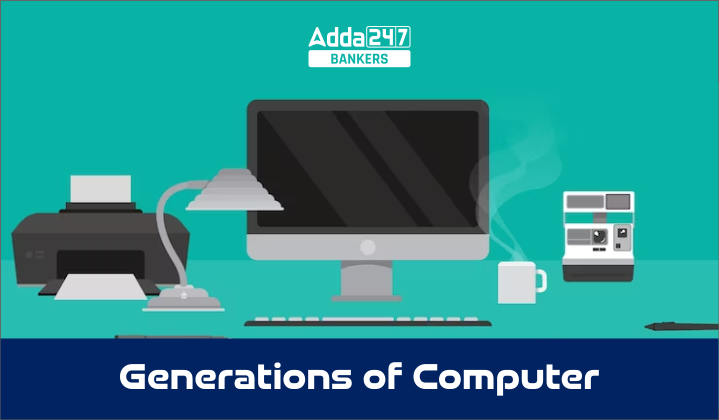Computers have become an integral part of our daily lives, revolutionizing the way we work and live. But the journey of computing technology dates back centuries. From using primitive tools such as sticks, stones, and bones for their mathematical needs to the development of the Abacus. The true evolution of computers began around the 16th century. Over the years, computers have undergone significant change and evolution with enhancement in terms of speed, accuracy, size, and affordability. These advancements have led to the modern computers we rely on today. In this article, we have covered the generation of computers their types and characteristics.
Generations of Computer
As we all know what is a computer and it’s use, but are you aware of the generation of computer? The concept of “generations” in computing refers to the evolutionary stages of technology. Initially, it was used to categorize computers based on hardware differences, but today, it is about both hardware and software components that make up a computer system. Over centuries the modern computer has reached its present state. There are five generations of computers, each with its own distinctive features and characterstics.
- First Generation Computers (1940-1956)
- Second Generation Computers (1956-1963)
- Third Generation Computers (1964-1971)
- Fourth Generation Computers (1971-Present)
- Fifth Generation Computers (Present and Beyond)
| Generation | Time Period | Technology Used |
|---|---|---|
| 1st Generation | 1940s – 1950s | Vacuum Tube Based |
| 2nd Generation | 1950s – 1960s | Transistor Based |
| 3rd Generation | 1960s – 1970s | Integrated Circuit Based |
| 4th Generation | 1970s – Present | Microprocessor Based |
| 5th Generation | Present – Future | Artificial Intelligence Based |
First Generation Computers
The first generation of computers marked a significant milestone in technological history. These computers relied on vacuum tubes to regulate the flow of electricity within a vacuum. Vacuum tubes were commonly used in various devices like switches, amplifiers, radios, and televisions during that time. But they were massive and unwieldy, far from the compact machines we have today. Programming them was quite challenging as they lacked sophisticated operating systems. In fact, users had to deal with rudimentary programming methods. Another drawback was their substantial space and power requirements. First-generation often needed entire rooms for operation and consumed huge amount of electricity.
Some noteworthy examples of first-generation computers include:
- ENIAC (Electronic Numerical Integrator and Computer): This colossal machine, constructed by J. Presper Eckert and John V. Mauchly, incorporated a staggering 18,000 vacuum tubes.
- EDVAC (Electronic Discrete Variable Automatic Computer): Designed by Von Neumann, this computer represented a significant advancement in computing technology.
- UNIVAC (Universal Automatic Computer): Developed by Eckert and Mauchly in 1952, UNIVAC was another remarkable creation of the first-generation computer era.
- Characteristics of 1st Generation Computers
These computers were designed using vacuum tubes. - Programming in these computers was done using machine languages.
- The main memory of 1st Generation Computers consisted of magnetic tapes and magnetic drums.
- Paper tapes and Punched cards were used as input/output devices in these computers.
- These computers were very huge but worked very slowly.
- Examples of 1st Generation Computers are IBM 650, IBM 701, ENIAC, UNIVAC1, etc.
Second Generation Computers
Second-generation computers were a big leap forward. They replaced the bulky vacuum tubes with smaller and more efficient transistors, which are like tiny switches. These transistors were invented at Bell Labs and made the computers faster and more powerful. One of the best things about transistors is that they don’t get as hot as vacuum tubes, so these new computers were smaller and easier to work with. In this generation, computers got their own “brain” called the Central Processing Unit (CPU), along with memory and other important parts. This set the stage for the computers we use today. Also, during this time, new programming languages like FORTRAN, ALGOL, and COBOL were developed, making it easier for people to tell the computer what to do.
Characteristics of Second-Generation Computers
- The Second Generation computers used the technology of Transistors.
- Machine language and Assembly Languages were used for these computers.
- Magnetic core and magnetic tape/disk were used for memory storage.
- The Second Generation Computers were smaller in size, consumed less power, and generated less heat.
- Magnetic tape and punched cards were used as input/output devices.
- Some of the examples are PDP-8, IBM1400 series, IBM 7090 and 7094, UNIVAC 1107, CDC 3600, etc.
Third Generation Computers
The Third Generation Computers marked a significant advancement by moving from transistors to integrated circuits, often called ICs. These computers were known for their speed and reliability. Instead of individual transistors, they used silicon chips, which were tiny slices of silicon containing numerous transistors, registers, and capacitors. This innovation greatly boosted memory capacity and overall efficiency. Additionally, this era saw the introduction of higher-level programming languages like BASIC, making it easier for people to interact with computers. Minicomputers also made their debut during this period.
Characteristics of Third-Generation Computers
- These computers were built using Integrated Circuits (ICs).
- High-level programming languages were used for programming on these computers.
- Large magnetic core and magnetic tape/disk were used for memory storage.
- Magnetic tape, monitor, keyboard, printer, etc were used as input/output devices.
- Some of the examples of Third Generation Computers are IBM 360, IBM 370, PDP-11, NCR 395, B6500, UNIVAC 1108, etc.
Fourth Generation Computers
From 1972 to 2010, computers got a lot smaller and easier to carry around. This happened because of a special technology called microprocessors, which are tiny chips that can do all the important tasks inside a computer. During this time, computers became faster and could do many things at the same time, like running multiple programs. They also got better at managing memory and sharing their time between different tasks. One big change was that personal computers became popular, and people started connecting them together to form networks. This made it easier for everyone to use computers in their daily lives.
Characteristics of Fourth-Generation Computers
- The Fourth Generation Computers have been developed using the technology of Very-large-scale integration (VLSI) and the microprocessor (VLSI has thousands of transistors on a single microchip).
- Semiconductor memory such as RAM, ROM, etc was used for memory storage.
- Input/output devices such as pointing devices, optical scanning, keyboard, monitor, printer, etc were introduced.
- Some examples of Fourth Generation Computers are IBM PC, STAR 1000, APPLE II, Apple Macintosh, Alter 8800.
Fifth Generation Computers
The Fifth Generation of Computers uses something called Artificial Intelligence (AI) to make them act more like humans. You can see AI in things like voice recognition and entertainment. These computers are super fast and really tiny. Over the years, computers have gotten much better in terms of speed, accuracy, and size.
Characteristics of Fifth-Generation Computers
- 5th Generation Computers use Artificial Intelligence (AI) and Ultra Large-Scale Integration (ULSI) technology.
- They employ parallel processing, where multiple microprocessors work together.
- These computers can understand human language.
- They are small and portable.
- Input/Output devices include trackpad, touchscreen, pen, speech recognition, light scanner, printer, keyboard, monitor, and mouse.
- Examples include desktops, laptops, tablets, and smartphones.
The Evolution of Computers
The history of computers dates back several decades, with machines designed to perform mathematical calculations and automate various tasks. Over time, computers have evolved to become more powerful, compact, and versatile, enabling a wide range of applications and uses in various fields.
The first computers were large mechanical devices that relied on gears, levers, and other physical components to perform operations. These machines were slow and cumbersome, and their programming was limited to simple instructions.
In the mid-20th century, electronic computers were developed that used vacuum tubes and other components to speed up calculations and enable more complex programming. These computers were still large and expensive, but they paved the way for further advancements.
The Birth of Digital Computers
The development of digital computers in the 1950s and 1960s represented a significant milestone in computer technology. These machines used binary code to process information, enabling faster and more efficient computation.
| Computer Full Form: Digital Computers | ||
|---|---|---|
| Name | Year | Inventor |
| ENIAC | 1946 | John Presper Eckert and John W. Mauchly |
| UNIVAC | 1951 | John W. Mauchly and J. Presper Eckert |
| IBM 7090 | 1959 | IBM |
During this time, mainframe computers were also developed that were larger and more powerful than previous models. These machines were used primarily by large organizations and governments for data processing and scientific calculations.
The Age of Personal Computers
In the 1970s, the development of microprocessors and other technologies paved the way for the first personal computers. These machines were smaller, more affordable, and easier to use than mainframe computers, making them accessible to individuals and small businesses. The introduction of the IBM PC in 1981 marked a turning point in the history of personal computers, with a standardized hardware and software platform that would become the industry standard.
The Rise of Mobile Computing
In recent years, computers have become even more portable and powerful, with the advent of laptops, tablets, and smartphones. These devices incorporate advanced technologies such as touch screens, voice recognition, and mobile networks to enable users to stay connected and productive on the go.
The evolution of computers has been driven by advances in technology, as well as changing user needs and expectations. Today, computers are used in a wide range of applications, from education and research to entertainment and communication, and they continue to shape the world in which we live.
History of Computer Generation
The history of computers is a tale of innovation and progress that has transformed the world. It begins with the massive, room-sized machines of the 1940s, like the ENIAC, which used vacuum tubes. Toady the world runs of computers with all the tasks of life linked to computers and utility they provide in life. Here we have mentioned few well known protype of computers that have marked the evolutionary stages of computers.
| Device | Inventor | Year | Description |
|---|---|---|---|
| Abacus | Chinese | Around 2000 BC | Wooden rack with metal rods and beads for arithmetic calculations. |
| Napier’s Bones | John Napier | 1617 | Manually operated calculating device using ivory strips marked with numbers. |
| Pascaline | Blaise Pascal | 1642-1644 | Considered the first mechanical and automatic calculator with gears. |
| Stepped Reckoner or Leibnitz Wheel | Gottfried Wilhelm Leibnitz | 1673 | An upgrade of Pascal’s invention, using fluted drums for calculations. |
| Difference Engine | Charles Babbage | Early 1820s | A steam-driven mechanical computer designed for solving tables of numbers. |
| Analytical Engine | Charles Babbage | 1830s | A mechanical computer using punch cards for input, capable of solving any mathematical problem. |
| Tabulating Machine | Herman Hollerith | 1890s | Mechanical tabulator based on punch cards for statistics and data processing. |
| Differential Analyzer | Vannevar Bush | 1930 | The first electronic computer introduced in the United States, capable of rapid calculations. |
| Mark I | Howard Aiken (IBM & Harvard) | 1944 | The first programmable digital computer, designed for large calculations. |
Importance of Computers in Today’s World
Computers play a vital role in our lives today. They are essential for work, education, communication, entertainment, and more. The advancement of technology has made computers faster, smarter, and more accessible than ever before. Here are some key ways in which computers are important in today’s world:
Productivity and Efficiency
Computers are crucial for streamlining work processes, increasing productivity, and improving efficiency. They enable us to automate many tasks, such as data entry, document creation, and financial management. This saves time, reduces errors, and allows us to focus on more important tasks.
Communication
Computers are the backbone of modern communication. They allow us to stay connected with friends, family, and colleagues across the globe through email, social media, and video conferencing. They have revolutionized the way we communicate and made it faster and more efficient than ever before.
Innovation and Creativity
Computers have opened up a world of possibilities for innovation and creativity. They provide a platform for artists, designers, musicians, and writers to create and share their work with a global audience. They also enable scientists and researchers to analyze complex data and gain new insights into the world around us.
Education
Computers have become an integral part of modern education. They provide students and teachers with access to vast amounts of information and resources, making learning more engaging and interactive. They also enable distance learning, allowing students to study from anywhere in the world.
Business
Computers are essential for running a business today. They enable businesses to manage finances, inventory, and customer relationships more efficiently. They also provide a platform for e-commerce, making it easier than ever for businesses to reach global markets.
In conclusion, computers are an indispensable part of our lives today. They have changed the way we live, work, and communicate. It is important to understand their significance and stay up-to-date with the latest advancements in technology.




 Tips to Prepare for Banking General Awar...
Tips to Prepare for Banking General Awar...
 Financial Awareness for Bank Exams 2025,...
Financial Awareness for Bank Exams 2025,...
 Zero Discrimination Day is Observed Ever...
Zero Discrimination Day is Observed Ever...


